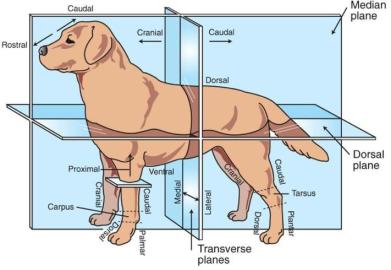
Lesson 1 Basic Terminology
Anatomy is the study of structure. Physiology is the study of function. Structure and function are inseparable as the foundation of the science and art of medicine. One must know the parts before one can appreciate how they work. Gross anatomy, the study of structures that can be dissected and observed with the unaided eye or with a hand lens, forms the subject matter of this guide. The anatomy of one part in relation to other parts of the body is topographical anatomy. The practical application of such knowledge in the diagnosis and treatment of pathological conditions is applied anatomy. The study of structures too small to be seen without a light microscope is microscopic anatomy. Examination of structure in even detail is possible with an electron microscope and constitutes ultrastructural anatomy. When an animal becomes diseased or its organs function improperly, its deviation from the normal is studied as pathological anatomy. The study of the development of the individual from the fertilized oocyte to birth is embryology, and from the zygote to the adult, it is known as developmental anatomy. The study of abnormal development is teratology.
An understanding of the following planes, positions, and directions relative to the animal body or its parts is necessary to follow the procedures for dissection
PLANE: A surface, real or imaginary, along which any two points can be connected by a straight line.
Median Plane: Divides the head, body, or limb longitudinally into equal right and left halves.
Sagittal Plane: Passes through the head, body, or limb parallel to the median plane.
Transverse Plane: Cuts across the head, body, or limb at a right angle to its long axis or across the long axis of an organ or a part.
Dorsal Plane: Runs at right angles to the median and transverse planes and thus divides the body or head into dorsal and ventral portions.
DORSAL: Toward or relatively near the back and corresponding surface of the head, neck, and tail; on the limbs it applies to the upper or front surface of the carpus, tarsus, metapodium, and digits (opposite to the side with the pads).
VENTRAL: Toward or relatively near the belly and the corresponding surface of the head, neck, thorax, and tail. This term is never used for the limbs.
MEDIAL: Toward or relatively near the median plane.
LATERAL: Away from or relatively farther from the median plane.
CRANIAL: Toward or relatively near the head; on the limbs it applies proximal to the carpus and tarsus. In reference to the head, it is replaced by the term rostral.
ROSTRAL: Toward or relatively near the nose; applies to the head only.
CAUDAL: Toward or relatively near the tail; on the limbs it applies proximal to the carpus and tarsus. Also used in reference to the head. The adjectives for directional terms may be modified to serve as adverbs by replacing the ending “al” with the ending “ally,” as in dorsally. Certain terms whose meanings are more restricted are used in the description of organs and appendages.upine position so that the palmar or plantar surface will face the substrate.


